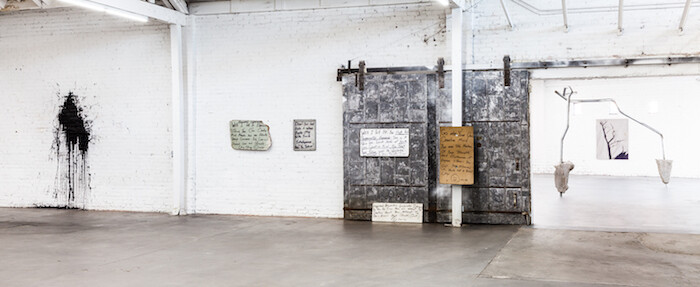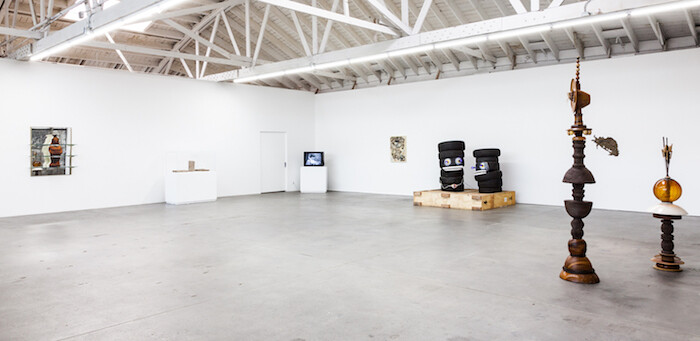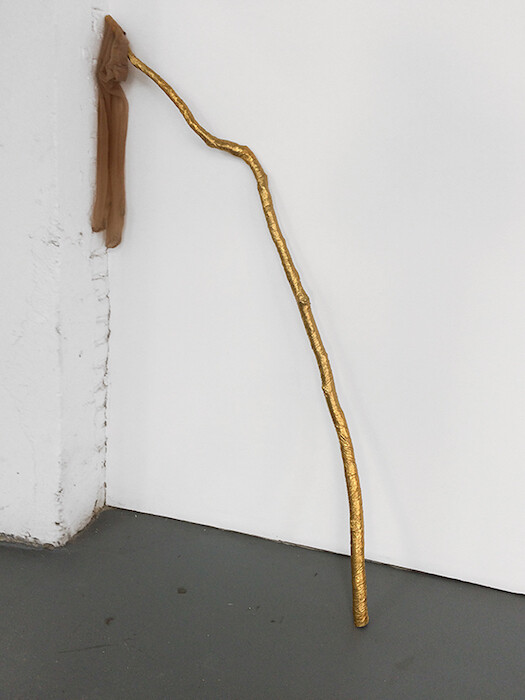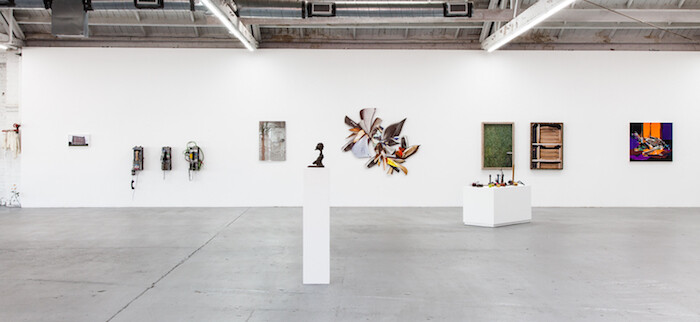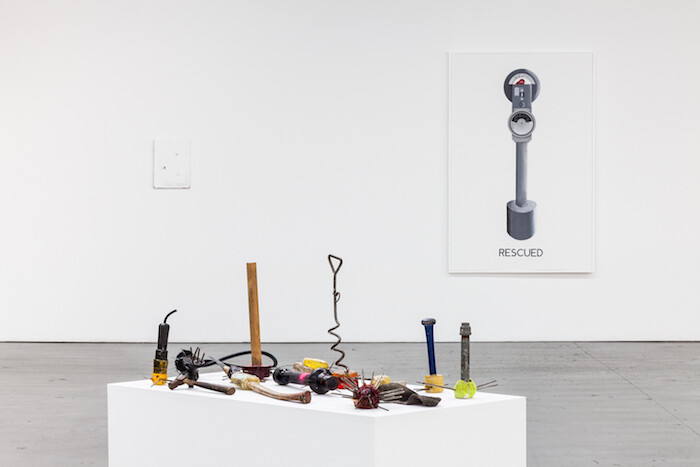Word on the street is they got the Crenshaw Cowboy. Into a gallery, that is. Anyone who has turned onto the westbound I-10 at Crenshaw Boulevard has likely noticed him, an itinerant junk-assemblage artist who shows his sculptures at the top of the onramp. He also gives advice on fame and creativity, by way of hand-painted signs—for example, on a curling particle board: “Go into Your Own Creative Mind You are The Master Of Your Thoughts And Behavior. If Anyone Stress’s [sic] You Out… You Allowed it… You’re not a Robot Okay : ) Smile.” Five of these signs appear in “Concrete Island” at Venus, Los Angeles, a show that, by way of J.G. Ballard’s novel of the same name, romances the aesthetic of those who eke out a living in the city’s gaps.
Of the 31 artists and collectives included, only the Crenshaw Cowboy is homeless. Indeed, a wide gulf separates the rush-hour panhandler from the gallery artist. Add to this the fact that Venus’s polished square footage is part of an archipelago of new galleries gentrifying the warehouse district of LA’s Boyle Heights. The homeless there have been pushed out; nearby homeowners may soon join them. Perhaps the inclusion of the Crenshaw Cowboy is at least partly altruistic. But “Concrete Island” isn’t in the business of charity. A token nod towards real homelessness only makes it more callous that the show would rather dwell on a more abstract notion: that maybe artists, too, are outsiders, drifters, and castaways, for whom prescriptive society is a bad fit.
This much is the moral of Sterling Ruby’s Transient Trilogy (2005-2008), a video in which the artist himself plays a homeless person shuffling through the LA brush, compiling little bricolage sculptures from tinsel, hair ties, and pinkish goo. “I am an interior burnout,” says the detuned voiceover, “with an outside rainbow.” At least Ruby goes into the weeds himself, rather than gawking (although, when it comes to elective vagrancy as art, One Year Performance 1981–1982 by Tehching Hsieh remains the limit case); Ruby also parodies a certain type of artist (perhaps he is one himself) that seeks transcendence in precious scraps. The show relies on similar gestures toward junk art or found urbanism. Some are calculated but effective, such as Jedediah Caesar’s Mohave Laminates (2017): amber resin embedded with old plywood and other weathered objects then shaved into wall works. Others, like Kim Gordon’s Untitled (2017), a stick wrapped in gold lamé, seem plain silly.
If such refined dejection is meant to reduce, reuse, or refuse consumer culture, the white cube is an ironic frame. Max Hooper Schneider embodies this attitude with Shopping Cart (2017), the found, melted remains of a grocery cart given the finish of an iridescent bug. Many of the artists here conflate the mythos of the readymade with that of the ragpicker—but where authentic creativity has been exiled to the province of true outsiders, the “insider” artist must be content as a trash-world dilettante. As if desperate for something true, “Concrete Island” jumps the line between appreciation and appropriation. Thus Tony Matelli’s series of superrealistic painted bronze weeds seem to sprout from the baseboards; and thus Will Boone’s Stay There (2014), a few airbrushed lines on nicely framed paper, relocates a hobo’s secret shorthand from fenceposts and boxcars to a less practical substrate. Thankfully, in a show that mostly averts its eyes from uncomfortable facts, there are Harry Dodge’s Emergency Weapons (2002-2017), an array of improvised axes and maces made from tool handles (and even a dirty sock) tipped with nails in dingy pucks of resin. Life on the outskirts can be violent, and copping its aesthetic can be, too.
The soundtracks of two films dominate the show’s ambience, and might stand for its cringeworthy mix of empathy and exclusivity. Drifting like cheap incense are the two chords and croon (“Ain’t this lonely life so [unintelligible] …”) backing Untitled (Absence of Evidence is Evidence of Absence) (2016-17), a super-8 film by Sam Falls that features such images as a long take of a stray dog sleeping in a driveway; and, lancing its syrupy calm, the monologue in Kaari Upson’s Shadow Work (2009), where Upson tells us, “no one cares, no one ever will.” “Concrete Island,” reads an exhibition brochure, “where survival is avant-garde.” The very thought is a luxury. In Ballard’s novel, the protagonist isn’t just marooned on a traffic island—he’s there because he wrecked his Jaguar. It isn’t aesthetics that separates the concrete islanders from the tourists; it’s the privilege of mobility.
